Will Pfeifer's Blog, page 28
December 8, 2013
Movies I Watched in November, Part 1
As far as sitting on my couch and watching TV, November 2013 turned out to be a busy month. So I'm splitting the recap of films viewed into two parts. Here's the first chunk...
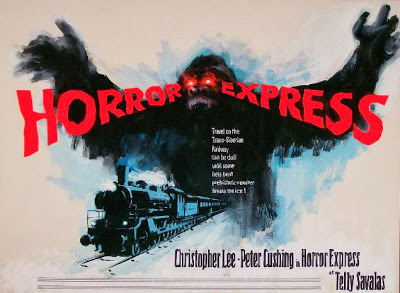
Pretty solid thriller about a monster in a crate on a train traveling across Asia that (of course) gets out of that crate and begins wreaking havoc on the claustrophobic space of the titular train. Horror legends Christopher Lee and Peter Cushing play rival scientists, and Telly Savalas (whose prominent billing contrasts with his short screen time) shows up near the end as a gypsy who gives the movie a jolt of energy. The monster itself is a low-tech affair with glowing red eyes, but somehow, in the context of the film, it just about manages to work.
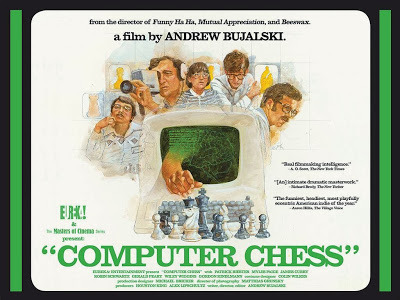
Mumblecore master Andrew Bujalski brings his distinctive (to say the least) touch to the world of primitive computer programming in this fascinating little movie set in hotel during a (what else) computer chess tournament. Shot on black-and-white video that mimics the technology of the era, it's funny, somber and even a bit surreal as it follows the paths of various programmers trying to navigate life in the late 1970s. Defiantly low-key and like no movie I've seen in a long time -- maybe ever -- and well worth a look if you're looking for something different. Really different.
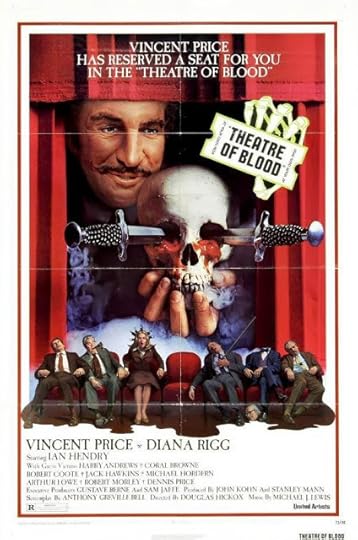
Like the Dr. Phibes films, this 1973 darkly comic thriller pits a revenge-obsessed Vincent Price against a group of insufferable prigs whom you can't wait to see fall victim to his deathtraps. The twist this time around is that Price is a Shakespearean actor getting back at the critics who've blasted him in their reviews, and all his murders are based on the works of the Bard. Price, who received some less-than-favorable notices in his career, must've had a blast in this movie, and he really hams it up in the best possible sense of the word. Diana Rigg plays his daughter, figuring into a plot twist I saw coming a mile away (which didn't ruin the fun), and the movie manages to generate a twisted, slightly nasty feeling that sets it apart from the wackier Phibes films. One of the movies I had left on my DVR after Turner Classic Movies' Halloween extravaganza, and one I'm very happy I watched before hitting "delete."
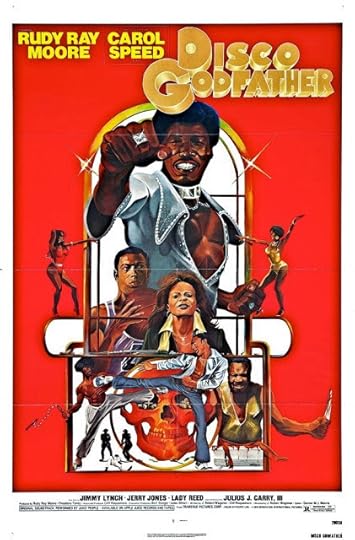
The great Rudy Ray Moore takes on the menace of angel dust in this indescribable artifact from 1979. Bargain basement dance numbers bump up against would-be social drama and some jaw-dropping fantasy sequences, with Rudy himself giving it his usual sense of absurd energy. Unlike other movies where he's fighting The Man, in this movie Rudy most definitely is The Man, a former cop worshipped by his former co-workers and generally seen as the only guy with a chance of getting Angel Dust off the streets. Un-be-lievable. You must see it. For a sample of its mad genius, read what I wrote about the film's opening credits here .
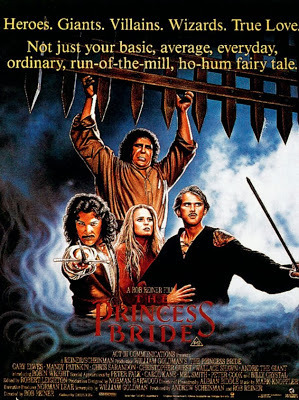
Now that Allie has (thankfully) moved out of the Disney princess phase, I thought I'd introduce her to a higher class of princess movie with this 1987 fairy tale from director Rob Reiner and writer William Goldman. I've been re-reading Goldman's books on screenwriting lately, and he shares plenty behind-the-scenes stories from "The Princess Bride" in "Which Lie Did I Tell," which made me want to re-watch it even more. Still holds up, I'm happy to say, with Cary Elwes coming off especially well as the hero, combining genuine charm with a real sense of heroic purpose. Also, it's a kick to see a relatively young Mandy Patinkin as a master swordsman, then tune into to "Homeland" every Sunday and see the same actor skulk through the shadowy corridors of power as a not-so-young CIA chief.
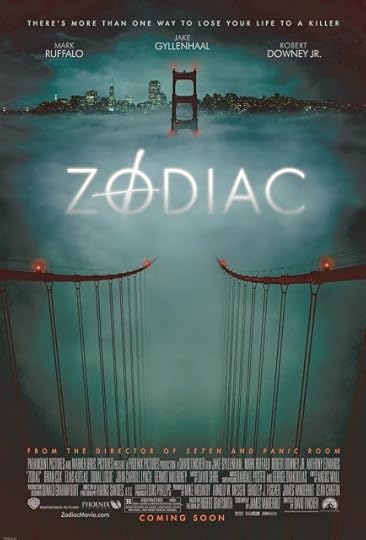
One of the greats. Seriously, if you've never seen it, stop reading this blog and correct that mistake immediately. Director David Fincher expertly recreates 1970s San Francisco, but even more than that, he creates a mystery that envelopes the lives of several unrelated men, then watches that mystery -- and their obsession -- play out for many, many years. Scariest line in the movie: "Before I kill you, I'm going to throw your baby out the window."
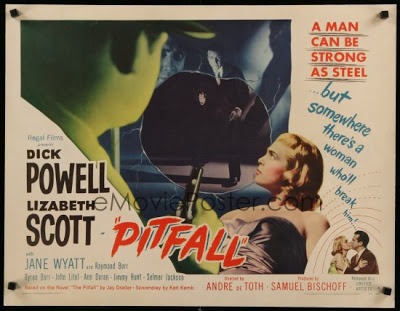
One of those much-heralded noirs that somehow slipped under my radar and never seemed to find its way onto DVD. Thankfully, Turner Classic Movies saved the day once again, giving it a rare screening in November. Not-so-happily married guy Dick Powell stumbles into a relationship with semi-femme fatale Lizabeth Scott, and things go downhill fast, pushed along in no small part by obsessive detective Raymond Burr. If you're a fan of film noir, do whatever you can to see this.
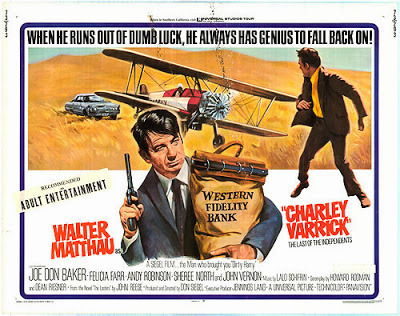
How great was Walter Matthau? I first encountered him as a kid in "The Bad News Bears," but he could play everything, from comedy to drama to thrillers. He's part of some of my very favorite movies, like "A Face in the Crowd" and "The Taking of Pelham 1-2-3," and as I plow through the twisted back alleys of Hollywood history, he keeps showing up in the most unexpected places. In this 1973 crime caper, he plays the title role, a very clever career criminal trying to save himself from mob retribution when he accidentally steals their money from a small town bank. Andrew Robinson and John Vernon provide strong support, but the most surprisingly element in "Charley Varrick" is Joe Don Baker, playing a hired gun. Looking almost exactly like a young Elvis Presley, he brings a real sense of cool menace to his role, upping the suspense stakes considerably.

Pretty solid thriller about a monster in a crate on a train traveling across Asia that (of course) gets out of that crate and begins wreaking havoc on the claustrophobic space of the titular train. Horror legends Christopher Lee and Peter Cushing play rival scientists, and Telly Savalas (whose prominent billing contrasts with his short screen time) shows up near the end as a gypsy who gives the movie a jolt of energy. The monster itself is a low-tech affair with glowing red eyes, but somehow, in the context of the film, it just about manages to work.

Mumblecore master Andrew Bujalski brings his distinctive (to say the least) touch to the world of primitive computer programming in this fascinating little movie set in hotel during a (what else) computer chess tournament. Shot on black-and-white video that mimics the technology of the era, it's funny, somber and even a bit surreal as it follows the paths of various programmers trying to navigate life in the late 1970s. Defiantly low-key and like no movie I've seen in a long time -- maybe ever -- and well worth a look if you're looking for something different. Really different.

Like the Dr. Phibes films, this 1973 darkly comic thriller pits a revenge-obsessed Vincent Price against a group of insufferable prigs whom you can't wait to see fall victim to his deathtraps. The twist this time around is that Price is a Shakespearean actor getting back at the critics who've blasted him in their reviews, and all his murders are based on the works of the Bard. Price, who received some less-than-favorable notices in his career, must've had a blast in this movie, and he really hams it up in the best possible sense of the word. Diana Rigg plays his daughter, figuring into a plot twist I saw coming a mile away (which didn't ruin the fun), and the movie manages to generate a twisted, slightly nasty feeling that sets it apart from the wackier Phibes films. One of the movies I had left on my DVR after Turner Classic Movies' Halloween extravaganza, and one I'm very happy I watched before hitting "delete."

The great Rudy Ray Moore takes on the menace of angel dust in this indescribable artifact from 1979. Bargain basement dance numbers bump up against would-be social drama and some jaw-dropping fantasy sequences, with Rudy himself giving it his usual sense of absurd energy. Unlike other movies where he's fighting The Man, in this movie Rudy most definitely is The Man, a former cop worshipped by his former co-workers and generally seen as the only guy with a chance of getting Angel Dust off the streets. Un-be-lievable. You must see it. For a sample of its mad genius, read what I wrote about the film's opening credits here .

Now that Allie has (thankfully) moved out of the Disney princess phase, I thought I'd introduce her to a higher class of princess movie with this 1987 fairy tale from director Rob Reiner and writer William Goldman. I've been re-reading Goldman's books on screenwriting lately, and he shares plenty behind-the-scenes stories from "The Princess Bride" in "Which Lie Did I Tell," which made me want to re-watch it even more. Still holds up, I'm happy to say, with Cary Elwes coming off especially well as the hero, combining genuine charm with a real sense of heroic purpose. Also, it's a kick to see a relatively young Mandy Patinkin as a master swordsman, then tune into to "Homeland" every Sunday and see the same actor skulk through the shadowy corridors of power as a not-so-young CIA chief.

One of the greats. Seriously, if you've never seen it, stop reading this blog and correct that mistake immediately. Director David Fincher expertly recreates 1970s San Francisco, but even more than that, he creates a mystery that envelopes the lives of several unrelated men, then watches that mystery -- and their obsession -- play out for many, many years. Scariest line in the movie: "Before I kill you, I'm going to throw your baby out the window."

One of those much-heralded noirs that somehow slipped under my radar and never seemed to find its way onto DVD. Thankfully, Turner Classic Movies saved the day once again, giving it a rare screening in November. Not-so-happily married guy Dick Powell stumbles into a relationship with semi-femme fatale Lizabeth Scott, and things go downhill fast, pushed along in no small part by obsessive detective Raymond Burr. If you're a fan of film noir, do whatever you can to see this.

How great was Walter Matthau? I first encountered him as a kid in "The Bad News Bears," but he could play everything, from comedy to drama to thrillers. He's part of some of my very favorite movies, like "A Face in the Crowd" and "The Taking of Pelham 1-2-3," and as I plow through the twisted back alleys of Hollywood history, he keeps showing up in the most unexpected places. In this 1973 crime caper, he plays the title role, a very clever career criminal trying to save himself from mob retribution when he accidentally steals their money from a small town bank. Andrew Robinson and John Vernon provide strong support, but the most surprisingly element in "Charley Varrick" is Joe Don Baker, playing a hired gun. Looking almost exactly like a young Elvis Presley, he brings a real sense of cool menace to his role, upping the suspense stakes considerably.
Published on December 08, 2013 16:41
December 4, 2013
Great Moments in Comics History, Part 37
Jaime Hernandez predicts a female Robin almost four years before Frank Miller's "The Dark Knight Returns" is published.
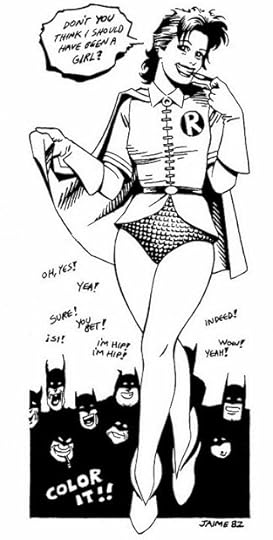
Sketch in The Comics Journal, Oct. 1982. Art by Jaime Hernandez

Sketch in The Comics Journal, Oct. 1982. Art by Jaime Hernandez
Published on December 04, 2013 18:26
November 22, 2013
Great Moments in Comics History, Part 36
National Lampoon imagines what might have been
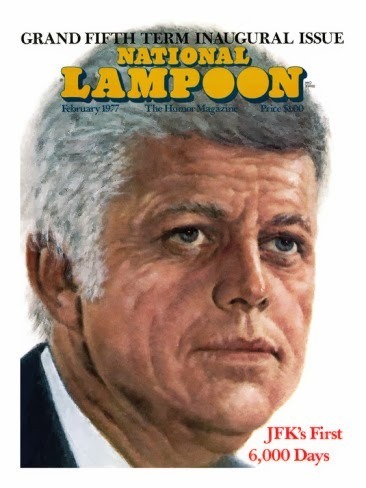
National Lampoon, Feb. 1977 issue. Script, art, etc. by various.

National Lampoon, Feb. 1977 issue. Script, art, etc. by various.
Published on November 22, 2013 06:56
November 15, 2013
Great Moments in Comics History, Part 35
George Lucas demands the Death Star pay its electric bill.
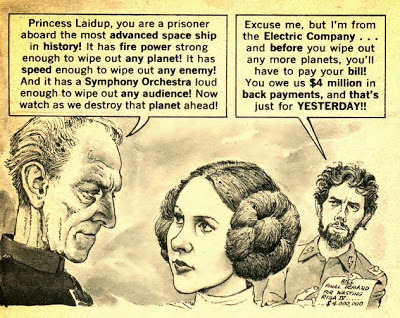
"Star Roars," Mad Magazine, Jan. 1978. Script by Larry Siegel and Dick De Bartolo, art by Harry North, Esq.

"Star Roars," Mad Magazine, Jan. 1978. Script by Larry Siegel and Dick De Bartolo, art by Harry North, Esq.
Published on November 15, 2013 06:18
November 12, 2013
Let's all take a moment to enjoy the opening titles of "Disco Godather"
A few days ago, I harnessed the global power of my Twitter account to share this message: "Upon further review, I've determined that Disco Godfather is the greatest film of all time."
I was exaggerating, but I wasn't lying.
From the opening titles to the final shot, this jaw-dropping combination of action epic, social drama and disco extravaganza had me riveted. I don't want to spoil that final shot -- because, I have to admit, it is genuinely surprising -- but I would like to showcase the glory of those opening titles. They let youknow, right off the bat, that you're about to see something special...
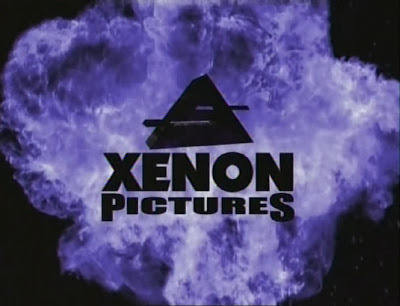
First up, the logo for Xenon pictures, which, according to t Wikipedia, was founded in 1986 and " is recognized in the industry for developing the nation's first label for black independent cinema." Needless to say, black cinema doesn't get much more independent than a Rudy Ray Moore production. But this is just the video label, added years after the original 1979 release of "Disco Godfather." So let's move on to the actual production company logos...
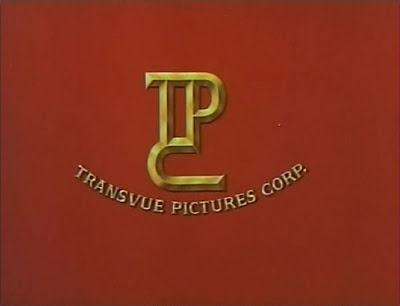
According to the IMDB page for Transvue Pictures Corp., this is the last movie the company released. At least they went out in a blaze of glory.
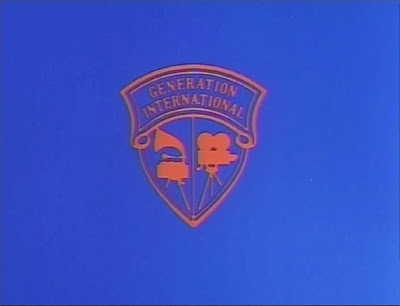
I couldn't find out any information about this, possibly the most generically-named company in the history of commerce.
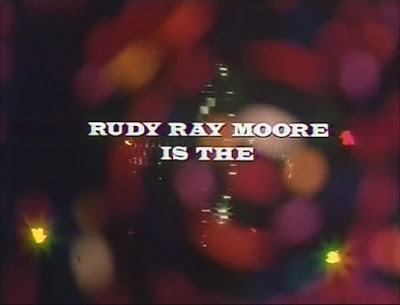
And here he is, the main event, the man you came to see. This was Rudy Ray Moore's last real starring role, and when you look at his career, he only really has four major (and that's using the word extremely loosely) movies to his credit. But it was enough to make him a cult movie legend -- and if you've seen any of those four films, you know why.
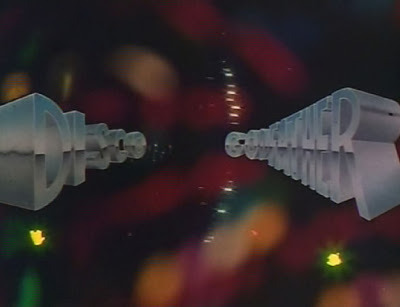
The main title of "Disco Godfather," which even on my large hi-def TV, was a little hard to read. I'm guessing it was more legible on a giant movie screen in the late 1970s. Hell, I'm guessing it was downright glorious.
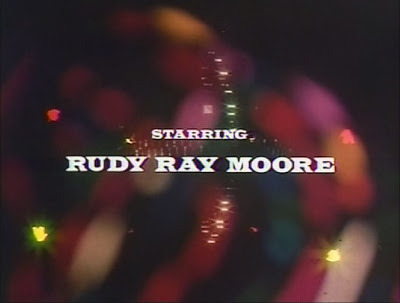
In case you forgot the screen announcing him that flashed by about 10 seconds before this one.
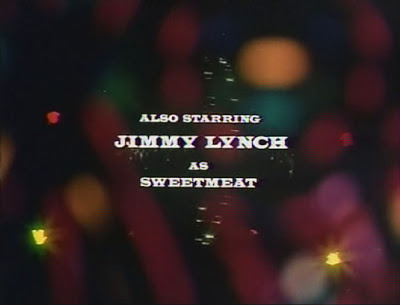
When you see that the movie you're about to watch features a character by the name of "Sweetmeat," you know you're in for a good time. Sweetmeat, incidentally, is a gentlemen of leisure who shows up for one memorable scene at a party where a giant pile of cocaine is being snorted off a copy of the "Saturday Night Fever" soundtrack.
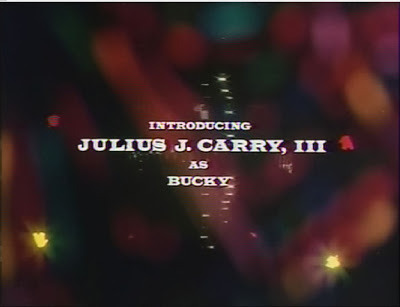
Julius J. Carry III plays Bucky, the Disco Godfather's nephew who overdoses on PCP and inspires his uncle to "attack the wack" and declare war on the city's drug lord. (Who also happens to be a local tycoon launching his own basketball team that Bucky was going to be a part of. It's that sort of movie.) Actually, Julius Carry found a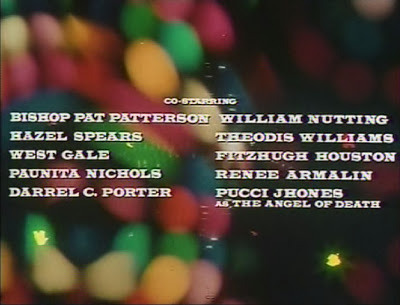
I didn't recognize any of these actors, but I wanted to shine a spotlight on that last credit -- "Pucci Jhones as The Angel of Death." Again, like seeing a character named "Sweetmeat," this is a sign that you're about to experience something truly special.
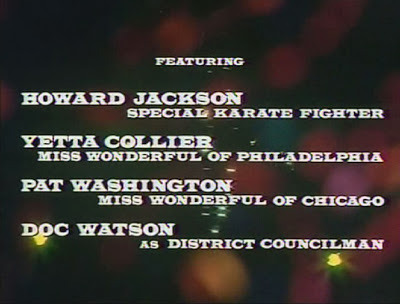
Another set of credits you would only see in a Rudy Ray Moore movie. I'm glad the two Miss Wonderfuls were able to get their moments on the big screen, but after watching "Disco Godfather," I can honestly say I have no idea who they were. But Howard Jackson -- he's another story. There's a scene at the end where the Disco Godfather finally arrives at the villain's hideout, and just as he's getting his ass kicked by an army of thugs, a random stranger walks up and starts karate chopping every badguy in sight. Clearly, this could only be Howard Jackson, Special Karate Fighter.
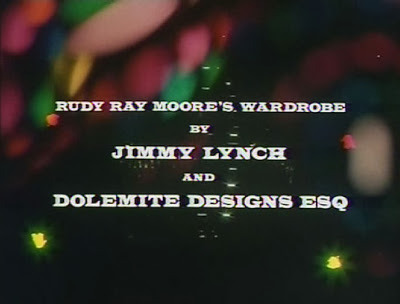
And though there are the usual credits for the director, the writers and the other folks who brought all this magic to the screen, the last one that really counts is this one. Why oh why, Dolemite Designs Esq, did you never become as much a force in fashion as, say, Men's Wearhouse?
Special thanks, by the way, to the programmers at Turner Classic Movies for recognizing that "classics" come in all shapes and sizes and for finding a spot for this one in their late-night TCM Underground lineup. I've said it before, and I'll say it again: If I had to choose between Turner Classic Movies and every other cable channel in existence, it would be a very easy choice.
I was exaggerating, but I wasn't lying.
From the opening titles to the final shot, this jaw-dropping combination of action epic, social drama and disco extravaganza had me riveted. I don't want to spoil that final shot -- because, I have to admit, it is genuinely surprising -- but I would like to showcase the glory of those opening titles. They let youknow, right off the bat, that you're about to see something special...

First up, the logo for Xenon pictures, which, according to t Wikipedia, was founded in 1986 and " is recognized in the industry for developing the nation's first label for black independent cinema." Needless to say, black cinema doesn't get much more independent than a Rudy Ray Moore production. But this is just the video label, added years after the original 1979 release of "Disco Godfather." So let's move on to the actual production company logos...

According to the IMDB page for Transvue Pictures Corp., this is the last movie the company released. At least they went out in a blaze of glory.

I couldn't find out any information about this, possibly the most generically-named company in the history of commerce.

And here he is, the main event, the man you came to see. This was Rudy Ray Moore's last real starring role, and when you look at his career, he only really has four major (and that's using the word extremely loosely) movies to his credit. But it was enough to make him a cult movie legend -- and if you've seen any of those four films, you know why.

The main title of "Disco Godfather," which even on my large hi-def TV, was a little hard to read. I'm guessing it was more legible on a giant movie screen in the late 1970s. Hell, I'm guessing it was downright glorious.

In case you forgot the screen announcing him that flashed by about 10 seconds before this one.

When you see that the movie you're about to watch features a character by the name of "Sweetmeat," you know you're in for a good time. Sweetmeat, incidentally, is a gentlemen of leisure who shows up for one memorable scene at a party where a giant pile of cocaine is being snorted off a copy of the "Saturday Night Fever" soundtrack.

Julius J. Carry III plays Bucky, the Disco Godfather's nephew who overdoses on PCP and inspires his uncle to "attack the wack" and declare war on the city's drug lord. (Who also happens to be a local tycoon launching his own basketball team that Bucky was going to be a part of. It's that sort of movie.) Actually, Julius Carry found a

I didn't recognize any of these actors, but I wanted to shine a spotlight on that last credit -- "Pucci Jhones as The Angel of Death." Again, like seeing a character named "Sweetmeat," this is a sign that you're about to experience something truly special.

Another set of credits you would only see in a Rudy Ray Moore movie. I'm glad the two Miss Wonderfuls were able to get their moments on the big screen, but after watching "Disco Godfather," I can honestly say I have no idea who they were. But Howard Jackson -- he's another story. There's a scene at the end where the Disco Godfather finally arrives at the villain's hideout, and just as he's getting his ass kicked by an army of thugs, a random stranger walks up and starts karate chopping every badguy in sight. Clearly, this could only be Howard Jackson, Special Karate Fighter.

And though there are the usual credits for the director, the writers and the other folks who brought all this magic to the screen, the last one that really counts is this one. Why oh why, Dolemite Designs Esq, did you never become as much a force in fashion as, say, Men's Wearhouse?
Special thanks, by the way, to the programmers at Turner Classic Movies for recognizing that "classics" come in all shapes and sizes and for finding a spot for this one in their late-night TCM Underground lineup. I've said it before, and I'll say it again: If I had to choose between Turner Classic Movies and every other cable channel in existence, it would be a very easy choice.
Published on November 12, 2013 08:12
November 10, 2013
Great Moments in Comics History, Part 34
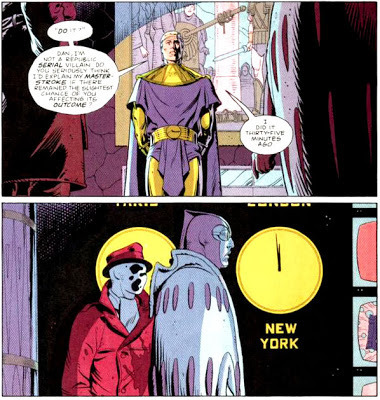
Ozymandias reveals that the heroes are too late to save the day; the heroes stand in shocked silence.
"Look Upon My Works, Ye Mighty..." Watchmen #11, Aug. 1987, script by Alan Moore; pencils, inks and letters by Dave Gibbons, colors by John Higgins.
As comic book moments go, this is a pretty well-known one, but I'd like to say a few words about why it has such a devastating impact: It's because, for the entire 11 issues of the series leading up to Ozymandias' second word balloon, the comic book has been subtly preparing us for a huge event to happen at midnight. Think about all those clocks, all those bloody smiley face badges, all the hundreds of versions of a circle with a line that Moore and Gibbons packed into this comic, every single one of them suggesting we're on the brink of something, something huge, and it's going to happen at midnight. Even if you never consciously thought about it, that image was burrowing itself into your brain for hundreds of pages. So, when Rorschach and Nite-Owl finally confront Ozymandias and the clock is edging toward midnight New York time (where the great majority of Watchmen takes place), we naturally figure that they've arrived at the nick of time.
And then we learn -- at the same moment they learn -- that they in fact haven't. That they're 35 minutes late. And that's when, on the last page, we see the destruction in New York begin, it's actually a flashback to 11:25 p.m. By midnight, it's all over.
And that's one reason (of many) why Watchmen is so damned brilliant.
Published on November 10, 2013 08:18
November 4, 2013
Nick Cardy, RIP
Legendary comic book artist Nick Cardy died yesterday at the age of 93. Long before I ever collected comic books in any sort of organized manner, I was a fan of Cardy's work, even if I didn't know his name. And it all started with this book...
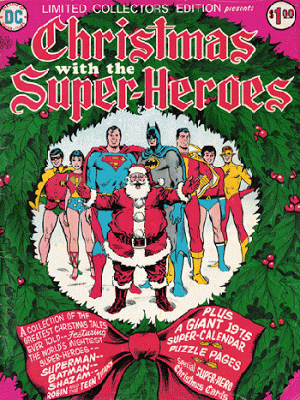
Published in 1975, when I was eight years old, it was one of those giant DC reprint collections obviously released for the Christmas season. I can't remember if my mom and dad gave it to me on Christmas or bought it a few days earlier to keep me occupied, but I do know I read it over and over (and over) and, as a matter of fact, still have it. And Nick Cardy drew that cheery cover.
What's more, he also drew the most memorable story inside, "The TT's Swingin' Christmas Carol." Originally published for Christmas 1967 in Teen Titans #13, it's got a typically crazed script from Bob Haney that updates Dickens' immortal tale for the late 1960s, with a mod-looking Tiny Tim, a junkyard-owning Scrooge and some sort of magic gizmo that turns trash into new products. But, most importantly, it's got some truly stellar art by Nick Cardy -- and boy oh boy, did that art look great in "Christmas with the Superheroes." The paper was sub pulp grade and the printing was muddy, but none of that mattered because it was SO BIG.
Cardy was an artist who never felt bound by the standard comic book grid, and in this story he really cuts loose, eliminating panel borders, overlapping action and giving the entire story an amazing sense of movement. Here's a moment near the end where Mr. Scrounge finally starts to feel the Christmas spirit...
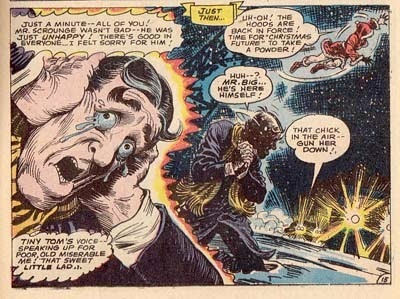
I love how everything seems so animated. The perspective jumps from a tight close-up on Scrounge to a much wider shot, with the blues and blacks making the yellows of the headlights and the red of Wonder Girl's Santa suit pop off the page. (Colors, incidentally, are courtesy of Helen Vesik). And bringing it all to life is Cardy's distinctive inking style, with perfectly applied cross-hatching lending every element a solid, lived-in reality.
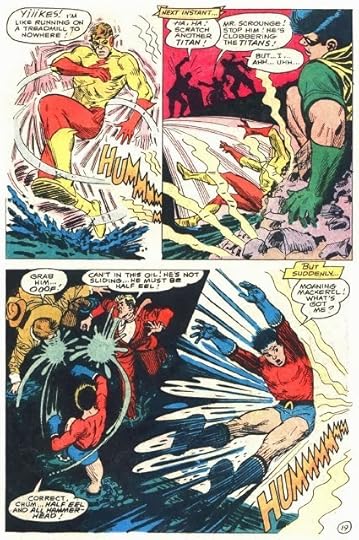
Here's a page featuring the other Titans. Look at how Cardy pulls your eye across the top of the page with Kid Flash's speed lines and colorful costume going from panel 1 to panel 2. Then, in the bottom half of the page, he switches to an all-black background to make Aqualad stand out, and finally goes mostly white to pull Aqualad (and again, the reader) right off this page an onto the next. None of this, of course, is anything I consciously noticed when I was eight years old and reading it for the first time. But I did know that, as much fun as the other reprints in this volume were, none of them had the feeling of action and speed that this story possessed in spades.
And let's give credit where credit is due -- Cardy knew how to draw women. Here, for example, is a shot of Wonder Girl in her Santa suit trying not to be crushed in a car compacter. Cardy draws her like a real women, not some stick-figure with giant breasts but a solid-looking superhero you know could take care of herself in a fight. And, needless to say, she's damned sexy, too.
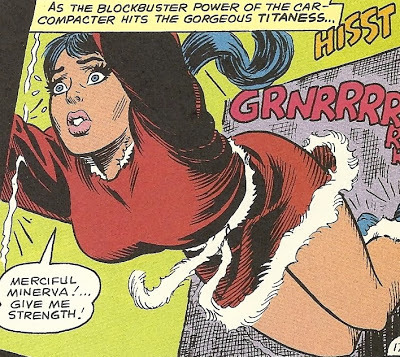
Of course, Nick Cardy drew a lot more than the Teen Titans. He also had a memorable run on Aquaman, and when I wrote several issue of that series about 10 years ago, we plopped San Diego into the Pacific, figuring that was a pretty bold move. And then I stumbled onto this memorable Aquaman cover at a comic book show...
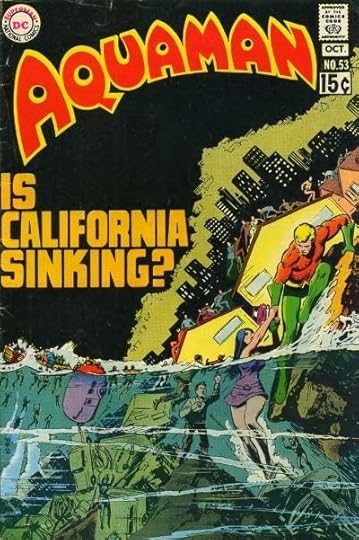
Cardy excelled as a cover artist, breaking just as many rules as he did on the interior pages. He would alter (or eliminate) the logo to drive the design, and used colors and negative space in a way very few artists were even attempting back then. If you're on Facebook and follow any comic book fans or pros, you'll see plenty of examples of his cover work. Everyone, it seemed, love how Cardy could bring an image to life, and though it's sad he's no longer with us, it's great to see so much beautiful art so lovingly remembered.
And, as a movie fan, I had to add this. Did you know Cardy painted several film posters, including this one for "Meatballs Part II"? The movie may be terrible (yes, in fact, it is), but I think we can agree that the poster is pretty damned gorgeous. Rest in peace, Mr. Cardy.
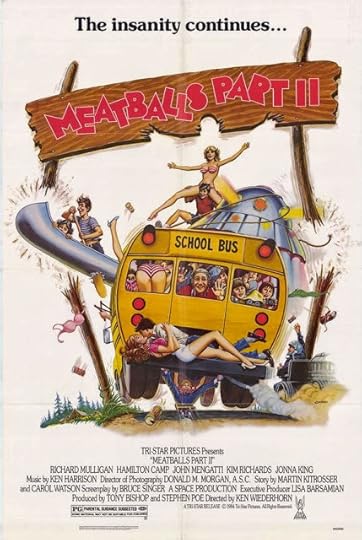

Published in 1975, when I was eight years old, it was one of those giant DC reprint collections obviously released for the Christmas season. I can't remember if my mom and dad gave it to me on Christmas or bought it a few days earlier to keep me occupied, but I do know I read it over and over (and over) and, as a matter of fact, still have it. And Nick Cardy drew that cheery cover.
What's more, he also drew the most memorable story inside, "The TT's Swingin' Christmas Carol." Originally published for Christmas 1967 in Teen Titans #13, it's got a typically crazed script from Bob Haney that updates Dickens' immortal tale for the late 1960s, with a mod-looking Tiny Tim, a junkyard-owning Scrooge and some sort of magic gizmo that turns trash into new products. But, most importantly, it's got some truly stellar art by Nick Cardy -- and boy oh boy, did that art look great in "Christmas with the Superheroes." The paper was sub pulp grade and the printing was muddy, but none of that mattered because it was SO BIG.
Cardy was an artist who never felt bound by the standard comic book grid, and in this story he really cuts loose, eliminating panel borders, overlapping action and giving the entire story an amazing sense of movement. Here's a moment near the end where Mr. Scrounge finally starts to feel the Christmas spirit...

I love how everything seems so animated. The perspective jumps from a tight close-up on Scrounge to a much wider shot, with the blues and blacks making the yellows of the headlights and the red of Wonder Girl's Santa suit pop off the page. (Colors, incidentally, are courtesy of Helen Vesik). And bringing it all to life is Cardy's distinctive inking style, with perfectly applied cross-hatching lending every element a solid, lived-in reality.

Here's a page featuring the other Titans. Look at how Cardy pulls your eye across the top of the page with Kid Flash's speed lines and colorful costume going from panel 1 to panel 2. Then, in the bottom half of the page, he switches to an all-black background to make Aqualad stand out, and finally goes mostly white to pull Aqualad (and again, the reader) right off this page an onto the next. None of this, of course, is anything I consciously noticed when I was eight years old and reading it for the first time. But I did know that, as much fun as the other reprints in this volume were, none of them had the feeling of action and speed that this story possessed in spades.
And let's give credit where credit is due -- Cardy knew how to draw women. Here, for example, is a shot of Wonder Girl in her Santa suit trying not to be crushed in a car compacter. Cardy draws her like a real women, not some stick-figure with giant breasts but a solid-looking superhero you know could take care of herself in a fight. And, needless to say, she's damned sexy, too.

Of course, Nick Cardy drew a lot more than the Teen Titans. He also had a memorable run on Aquaman, and when I wrote several issue of that series about 10 years ago, we plopped San Diego into the Pacific, figuring that was a pretty bold move. And then I stumbled onto this memorable Aquaman cover at a comic book show...

Cardy excelled as a cover artist, breaking just as many rules as he did on the interior pages. He would alter (or eliminate) the logo to drive the design, and used colors and negative space in a way very few artists were even attempting back then. If you're on Facebook and follow any comic book fans or pros, you'll see plenty of examples of his cover work. Everyone, it seemed, love how Cardy could bring an image to life, and though it's sad he's no longer with us, it's great to see so much beautiful art so lovingly remembered.
And, as a movie fan, I had to add this. Did you know Cardy painted several film posters, including this one for "Meatballs Part II"? The movie may be terrible (yes, in fact, it is), but I think we can agree that the poster is pretty damned gorgeous. Rest in peace, Mr. Cardy.

Published on November 04, 2013 09:11
November 2, 2013
Great Moments in Comics History, Part 33: Happy birthday, Steve Ditko!
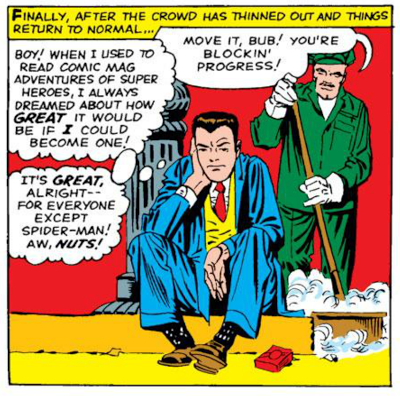
Peter Parker sits on the curb and bemoans his fate.
"Kraven the Hunter," Amazing Spider-Man #15, Aug. 1964, script by Stan Lee, pencils and inks by Steve Ditko, colors by Stan Goldberg, letters by Art Simek.
Published on November 02, 2013 06:04
November 1, 2013
Movies I Watched in October
Didn't watch as many horror movies as I planned to in October, but they did make up the majority of the lineup. Here's how it all went down:
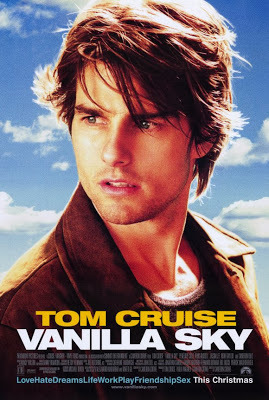
For reasons that I cannot begin to explain, I've seen this movie more than just about any other since it hit theaters back in 2001. I wasn't wild about it when I saw it on the big screen, and I didn't give it a very good review in my late, lamented (by me, at least) DVD column after Paramount was kind enough to send me a copy. Though the plot is fine -- rich guy (Cruise of course) gets in a horrible accident and has a tough time deciding what's real and what's not -- I found myself annoyed with writer/director Cameron Crowe's insufferable giddiness over what a delightful and challenging film he'd felt he made. (If you want to really experience this sense of nausea, listen to the commentary track in which Crowe's crowing (har har) is accompanied by his wife Nancy Wilson noodling on her gee-tar and, believe it or not, his kids interrupting the recording session.) But, over the years, when I needed some background noise and/or visuals, I'd find myself popping that free "Vanilla Sky" DVD into the player and, to my surprise, enjoying watching Tom Cruise's character get knocked off his privileged perch and struggle to get back on top again. It's still an aggravating movie, so pleased with how hip and clever it is, but I can't deny it's beautifully made and ticks along with the seductive rhythm of a big, old-fashioned Hollywood movie. In other words, I'm sure I'll be watching it again one of these days.
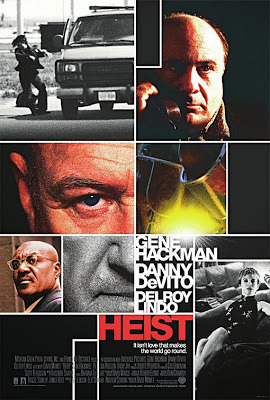
As a movie fan, I consider it one of the great cinema tragedies that with Gene Hackman now apparently retired, his last official screen credit is 2004's' "Welcome to Mooseport." So unworthy for a man whose resume includes "Bonnie and Clyde," "The French Connection," "The Conversation," "Hoosiers," "Unforgiven" and "The Royal Tenenbaums" (and yes, admittedly, "Loose Cannons"). Why couldn't it have been this twisty 2001 thriller from writer/director David Mamet? Hackman plays a career thief forced to pull (you guessed it) one last job before he sets sail into retirement. It has the requisite Mamet double- and triple-crosses, and Hackman, as good as he's ever been, gets solid support from Delroy Lindo, Sam Rockwell, Ricky Jay and Rebecca Pidgeon. Special praise goes to Danny DeVito, who's both very funny and very scary as the crime boss financing Hackman's robberies. Between re-watching this movie and mainlining episodes of "It's Always Sunny in Philadelphia," I've got a renewed respect for Mr. DeVito.
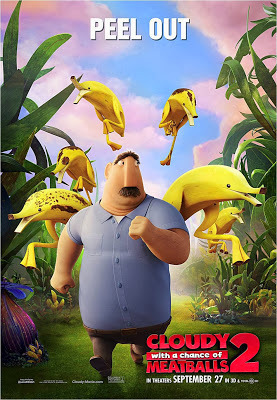
I loved the original "Cloudy with a Chance of Meatballs," which I watched and re-watched with Allie several times over the years. I had high hopes for this one, too, and while they were mostly met, I have to say it doesn't quite hit the crazed heights of its predecessor. It's hard to put my finger on, but something was just a bit off that knocked the sequel down a slot or two on the charts. Maybe it was the rhythm, which felt a little too frenetic, or the fact that the life lessons were just a bit too obvious this time around. Still, it looked amazing, evening more colorful than "Cloudy," and the jokes were still pretty solid. Worth a rental, at least, and if your kid becomes obsessed with it, you won't suffer too much sitting through repeated viewings.
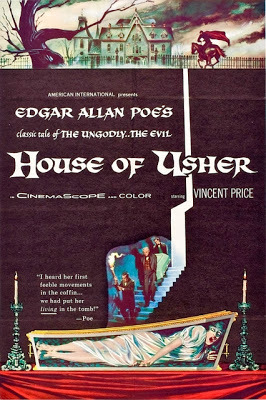
As a bit of Official Halloween Viewing, Amy and I watched this Roger Corman semi-classic, which I also got for free via the DVD column years ago. (Have I mentioned how much I miss having that column?) Vincent Price is, of course, a lot of fun, and the movie looks great in that lush style Corman somehow managed to achieve in his Poe adaptations. But the truth is, nothing much happens in the movie, and even though it's short, it tends to drag a bit. Not bad, but not great either. I do remember watching this in high school once, when the English teacher was obviously feeling a bit less than ambitious.
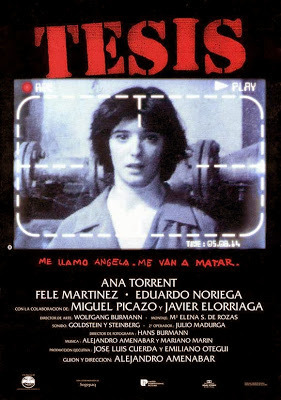
In a bit of cinematic synchronicity, I watched this movie from director Alejandro Amenabar the same month I rewatched "Vanilla Sky," which was based on Amenabar's 1997 movie, "Abre Los Ojos" ("Open Your Eyes"). This 1996 thriller focuses on eyes, too, except in this case they're not being opened by Penelope Cruz' seductive voice, they're shutting themselves so they don't have to watch someone get slaughtered in a snuff film. Ana Torrent plays Angela, a college student researching cinematic violence who stumbles across a snuff film library in the basement of her university. As she investigates the mystery, she meets two guys -- one a handsome lothario, one a scruffy film fan -- and it becomes obvious that at least one of them was behind the camera. Tense and troubling but never too slick or gory, "Tesis" builds to a creepy ending and even better unnerving epilogue. What's more, with its college-based focus on snuff films, it reminded me of my own comic book, "Finals," where the lead character was focused on "extreme cinema verite." In my comic, of course, he was the one behind the camera. Ah, funnybooks.
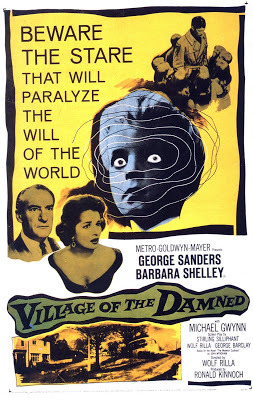
I know this is regarded as a classic of the genre, one of the first "creepy kid" movies ever made and a paragon of intelligent British science fiction. For years, I've had the double-feature DVD containing this and its sequel, "Children of the Damned" (another freebie -- oh, how I miss that column). But in all that time, I'd never watched it. This Halloween month, I decided to fill in that particular gap in my movie-watching knowledge. And ... well, you can see where this is going, can't you? I found myself unimpressed. The kids are more goofy than scary, the idea that everyone just sort of accepts a village-wide epidemic of pregnancies is never addressed in any believable way, and though George Sanders is always fun to watch (and listen to -- that voice!), he makes a pretty dull hero, muttering about his super-intelligent son until he finally decides to do something to prevent a global takeover by weird-eyed kids in blonde wigs. To tell the truth, my favorite part of the movie was the very beginning, when everyone in the village passes out and the authorities are left to stand at the edge of town, not daring to cross over a painted line. Now that was creepy.
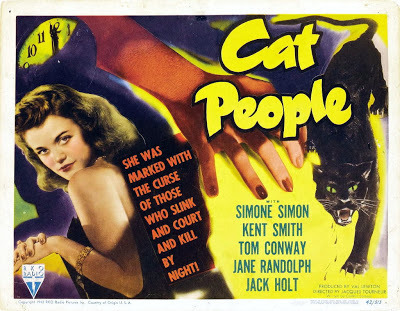
Thanks to the always fortuitous timing of TCM, I wound up this Halloween month watching one of my favorite horror movies -- hell, one of my favorite movies, period. I've written about "Cat People" before on this blog (here's my essay from 2007), but I find it endlessly fascinating and endlessly watchable. It's only 73 minutes long, but it contains so much that's memorable. There are the two justly famous scare scenes, of course, with the pursuit through Central Park and the stalking in the swimming pool still delivering jolts (and inspiring critical appraisal) more than 70 years later. And there's the contrast between Simone Simon's awkward, distinctly foreign performance and the all-American gusto of Kent Smith and Jane Randolph, which sets up the conflicts of the film all by itself. But what caught my eye this time around was the world of the movie, an impossibly seductive version of 1942 Manhattan that, of course, was really a few sets on the RKO lot. (The staircase in Irena's lobby was the same one Orson Welles used in "The Magnificent Ambersons.")
In his personal survey of horror, "Danse Macabre," Stephen King whines that he could never accept "Cat People" because the sets look so fake. Me? I like them because they're obviously fake. Somehow, director Jacques Tourneur and his crew created a more magical, more memorable version of New York perfectly fitting for the strange story of a woman who becomes a panther when her passions are stirred. It's the sort of movie world I'd like to live in -- or, at the very least, visit. That compact version of the Central Park Zoo? Irena's apartment? The diner, the Serbian restaurant and the basement pool? Me, I'd like to spend some time in all those locations, sketching animals, swimming laps and ordering late night pie and coffee. It's one reason -- one of many -- that "Cat People" claims such a high spot on my all-time movie list.

For reasons that I cannot begin to explain, I've seen this movie more than just about any other since it hit theaters back in 2001. I wasn't wild about it when I saw it on the big screen, and I didn't give it a very good review in my late, lamented (by me, at least) DVD column after Paramount was kind enough to send me a copy. Though the plot is fine -- rich guy (Cruise of course) gets in a horrible accident and has a tough time deciding what's real and what's not -- I found myself annoyed with writer/director Cameron Crowe's insufferable giddiness over what a delightful and challenging film he'd felt he made. (If you want to really experience this sense of nausea, listen to the commentary track in which Crowe's crowing (har har) is accompanied by his wife Nancy Wilson noodling on her gee-tar and, believe it or not, his kids interrupting the recording session.) But, over the years, when I needed some background noise and/or visuals, I'd find myself popping that free "Vanilla Sky" DVD into the player and, to my surprise, enjoying watching Tom Cruise's character get knocked off his privileged perch and struggle to get back on top again. It's still an aggravating movie, so pleased with how hip and clever it is, but I can't deny it's beautifully made and ticks along with the seductive rhythm of a big, old-fashioned Hollywood movie. In other words, I'm sure I'll be watching it again one of these days.

As a movie fan, I consider it one of the great cinema tragedies that with Gene Hackman now apparently retired, his last official screen credit is 2004's' "Welcome to Mooseport." So unworthy for a man whose resume includes "Bonnie and Clyde," "The French Connection," "The Conversation," "Hoosiers," "Unforgiven" and "The Royal Tenenbaums" (and yes, admittedly, "Loose Cannons"). Why couldn't it have been this twisty 2001 thriller from writer/director David Mamet? Hackman plays a career thief forced to pull (you guessed it) one last job before he sets sail into retirement. It has the requisite Mamet double- and triple-crosses, and Hackman, as good as he's ever been, gets solid support from Delroy Lindo, Sam Rockwell, Ricky Jay and Rebecca Pidgeon. Special praise goes to Danny DeVito, who's both very funny and very scary as the crime boss financing Hackman's robberies. Between re-watching this movie and mainlining episodes of "It's Always Sunny in Philadelphia," I've got a renewed respect for Mr. DeVito.

I loved the original "Cloudy with a Chance of Meatballs," which I watched and re-watched with Allie several times over the years. I had high hopes for this one, too, and while they were mostly met, I have to say it doesn't quite hit the crazed heights of its predecessor. It's hard to put my finger on, but something was just a bit off that knocked the sequel down a slot or two on the charts. Maybe it was the rhythm, which felt a little too frenetic, or the fact that the life lessons were just a bit too obvious this time around. Still, it looked amazing, evening more colorful than "Cloudy," and the jokes were still pretty solid. Worth a rental, at least, and if your kid becomes obsessed with it, you won't suffer too much sitting through repeated viewings.

As a bit of Official Halloween Viewing, Amy and I watched this Roger Corman semi-classic, which I also got for free via the DVD column years ago. (Have I mentioned how much I miss having that column?) Vincent Price is, of course, a lot of fun, and the movie looks great in that lush style Corman somehow managed to achieve in his Poe adaptations. But the truth is, nothing much happens in the movie, and even though it's short, it tends to drag a bit. Not bad, but not great either. I do remember watching this in high school once, when the English teacher was obviously feeling a bit less than ambitious.

In a bit of cinematic synchronicity, I watched this movie from director Alejandro Amenabar the same month I rewatched "Vanilla Sky," which was based on Amenabar's 1997 movie, "Abre Los Ojos" ("Open Your Eyes"). This 1996 thriller focuses on eyes, too, except in this case they're not being opened by Penelope Cruz' seductive voice, they're shutting themselves so they don't have to watch someone get slaughtered in a snuff film. Ana Torrent plays Angela, a college student researching cinematic violence who stumbles across a snuff film library in the basement of her university. As she investigates the mystery, she meets two guys -- one a handsome lothario, one a scruffy film fan -- and it becomes obvious that at least one of them was behind the camera. Tense and troubling but never too slick or gory, "Tesis" builds to a creepy ending and even better unnerving epilogue. What's more, with its college-based focus on snuff films, it reminded me of my own comic book, "Finals," where the lead character was focused on "extreme cinema verite." In my comic, of course, he was the one behind the camera. Ah, funnybooks.

I know this is regarded as a classic of the genre, one of the first "creepy kid" movies ever made and a paragon of intelligent British science fiction. For years, I've had the double-feature DVD containing this and its sequel, "Children of the Damned" (another freebie -- oh, how I miss that column). But in all that time, I'd never watched it. This Halloween month, I decided to fill in that particular gap in my movie-watching knowledge. And ... well, you can see where this is going, can't you? I found myself unimpressed. The kids are more goofy than scary, the idea that everyone just sort of accepts a village-wide epidemic of pregnancies is never addressed in any believable way, and though George Sanders is always fun to watch (and listen to -- that voice!), he makes a pretty dull hero, muttering about his super-intelligent son until he finally decides to do something to prevent a global takeover by weird-eyed kids in blonde wigs. To tell the truth, my favorite part of the movie was the very beginning, when everyone in the village passes out and the authorities are left to stand at the edge of town, not daring to cross over a painted line. Now that was creepy.

Thanks to the always fortuitous timing of TCM, I wound up this Halloween month watching one of my favorite horror movies -- hell, one of my favorite movies, period. I've written about "Cat People" before on this blog (here's my essay from 2007), but I find it endlessly fascinating and endlessly watchable. It's only 73 minutes long, but it contains so much that's memorable. There are the two justly famous scare scenes, of course, with the pursuit through Central Park and the stalking in the swimming pool still delivering jolts (and inspiring critical appraisal) more than 70 years later. And there's the contrast between Simone Simon's awkward, distinctly foreign performance and the all-American gusto of Kent Smith and Jane Randolph, which sets up the conflicts of the film all by itself. But what caught my eye this time around was the world of the movie, an impossibly seductive version of 1942 Manhattan that, of course, was really a few sets on the RKO lot. (The staircase in Irena's lobby was the same one Orson Welles used in "The Magnificent Ambersons.")
In his personal survey of horror, "Danse Macabre," Stephen King whines that he could never accept "Cat People" because the sets look so fake. Me? I like them because they're obviously fake. Somehow, director Jacques Tourneur and his crew created a more magical, more memorable version of New York perfectly fitting for the strange story of a woman who becomes a panther when her passions are stirred. It's the sort of movie world I'd like to live in -- or, at the very least, visit. That compact version of the Central Park Zoo? Irena's apartment? The diner, the Serbian restaurant and the basement pool? Me, I'd like to spend some time in all those locations, sketching animals, swimming laps and ordering late night pie and coffee. It's one reason -- one of many -- that "Cat People" claims such a high spot on my all-time movie list.
Published on November 01, 2013 17:43
October 31, 2013
Suggested Halloween Reading: The Final Chapter (Or Is it?)*
When I was a kid, I, like most boys of my generation, loved paging through books about monster movies. Long before I actually laid my eyes on any of the horror classics, I'd already screened them in my head, working from grainy stills and evocative descriptions in books like
"Great Monsters of the Movies"
and "Classics of the Horror Film." And though I own a lot of books about horror movies as an adult (and I mean a lot), I can safely say that if nine-year-old me walked into my house, the one he'd spend the most time with would be John Landis' "Monsters in the Movies."
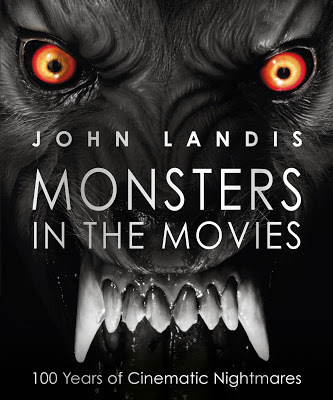
John Landis is, of course, the director responsible for "Animal House," "The Blues Brothers," "Trading Places" and, most fitting for this book, "An American Werewolf in London." But he's also a huge horror movie fan whose roots in the genre stretch back from his 1973 debut "Schlock" to his underrated 2010 movie "Burke and Hare." He's a regular at the excellent Trailers from Hell site, and his love for the genre is on every page of this huge, lavish coffee table book.
Divided into sections devoted to ghosts, mad scientists, vampires, werewolves, "Monstrous Apes," "Nature's Revenge" and other fitting categories, the book collects hundreds and hundreds of photos from what I'm guessing is just about every monster movie ever made. If it was (a) on film and (b) attempted to scare audiences, it's in here somewhere, stretching back to the earliest silent films. Accompanying each photo is a caption from Landis, offering a bit of historical insight along with his opinion. It makes the book more than just a very extensive photo album. Paging through "Monsters in the Movies" is like sitting down with Landis and talking about the entire history of horror cinema. It's not too serious or academic, but when you've finished the book, you'll have a real knowledge and appreciation for the genre.
Breaking up those photo-fueled chapters are interviews with some of the top folks in the horror business, including Joe Dante, Guillermo del Toro, Rick Baker, David Cronenberg and the late Ray Harryhausen. These are obviously guys Landis has known for years, and their conversations have the easy, relaxed feel of old friends talking about one of their favorite subjects. It's another element that elevates this book above those "1,000 Movies You Must See Before You Die" tomes that clog the remainder tables during the holidays. This one has a real sense of purpose and personality -- and, as a bonus, it contains way more than a mere 1,000 movies.
Let's be honest. Despite all the beer promotions and "sexy" Halloween costumes, Oct. 31 is really a day best appreciated by kids. They're still figuring out how the world works, and though life seems scary, fake frights -- like costumes and monsters movies (and books about monster movies) can help them get a better handle on what's real and what's not ... and what's really worth worrying about. I love "The Psychotronic Encyclopedia of Film" and other books aimed at older (if nor more mature) readers, but there's no book in my unnervingly vast library that takes me back to the Halloweens of my youth like "Monsters in the Movies." If you've got a kid -- or want to relive your own days as a kid -- consider this my highest recommendation.
Oh, and Happy Halloween!
*Yes, it is.

John Landis is, of course, the director responsible for "Animal House," "The Blues Brothers," "Trading Places" and, most fitting for this book, "An American Werewolf in London." But he's also a huge horror movie fan whose roots in the genre stretch back from his 1973 debut "Schlock" to his underrated 2010 movie "Burke and Hare." He's a regular at the excellent Trailers from Hell site, and his love for the genre is on every page of this huge, lavish coffee table book.
Divided into sections devoted to ghosts, mad scientists, vampires, werewolves, "Monstrous Apes," "Nature's Revenge" and other fitting categories, the book collects hundreds and hundreds of photos from what I'm guessing is just about every monster movie ever made. If it was (a) on film and (b) attempted to scare audiences, it's in here somewhere, stretching back to the earliest silent films. Accompanying each photo is a caption from Landis, offering a bit of historical insight along with his opinion. It makes the book more than just a very extensive photo album. Paging through "Monsters in the Movies" is like sitting down with Landis and talking about the entire history of horror cinema. It's not too serious or academic, but when you've finished the book, you'll have a real knowledge and appreciation for the genre.
Breaking up those photo-fueled chapters are interviews with some of the top folks in the horror business, including Joe Dante, Guillermo del Toro, Rick Baker, David Cronenberg and the late Ray Harryhausen. These are obviously guys Landis has known for years, and their conversations have the easy, relaxed feel of old friends talking about one of their favorite subjects. It's another element that elevates this book above those "1,000 Movies You Must See Before You Die" tomes that clog the remainder tables during the holidays. This one has a real sense of purpose and personality -- and, as a bonus, it contains way more than a mere 1,000 movies.
Let's be honest. Despite all the beer promotions and "sexy" Halloween costumes, Oct. 31 is really a day best appreciated by kids. They're still figuring out how the world works, and though life seems scary, fake frights -- like costumes and monsters movies (and books about monster movies) can help them get a better handle on what's real and what's not ... and what's really worth worrying about. I love "The Psychotronic Encyclopedia of Film" and other books aimed at older (if nor more mature) readers, but there's no book in my unnervingly vast library that takes me back to the Halloweens of my youth like "Monsters in the Movies." If you've got a kid -- or want to relive your own days as a kid -- consider this my highest recommendation.
Oh, and Happy Halloween!
*Yes, it is.
Published on October 31, 2013 06:58
Will Pfeifer's Blog
- Will Pfeifer's profile
- 23 followers
Will Pfeifer isn't a Goodreads Author
(yet),
but they
do have a blog,
so here are some recent posts imported from
their feed.



